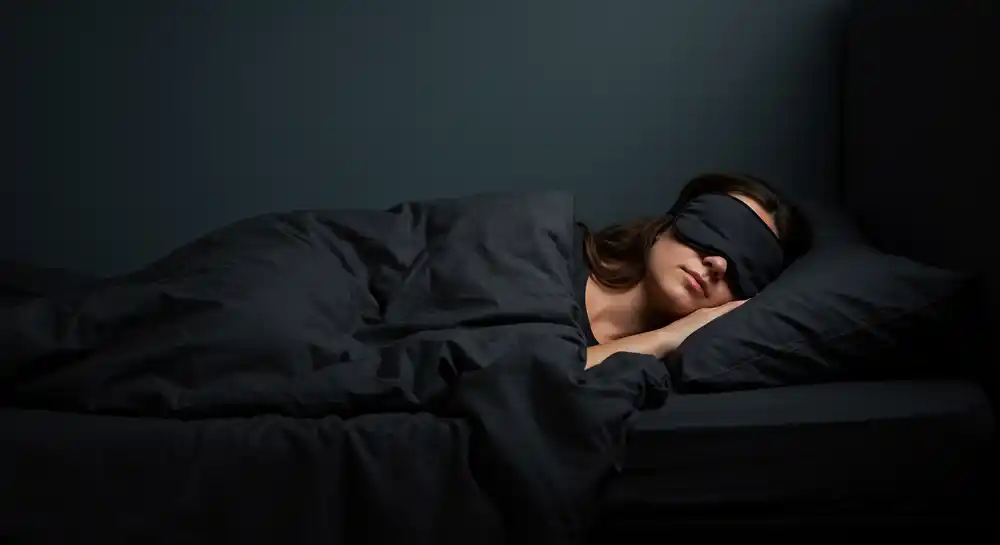Sleep Well With Biohacking: A Simple 5-Step Plan to Wake Up Energized (Even If You Struggle Now)

You’ve heard it all before: no caffeine after 2PM, keep your bedroom cool, turn off electronics an hour before bed. Yet despite following these rules, quality sleep remains frustratingly elusive.
The problem isn’t your willpower. It’s that generic “sleep well advice” overlooks what your unique biology actually needs.
That’s where how to get better sleep well with biohacking comes in—not as another rigid routine or expensive tech obsession, but as a personalized approach that works with your body’s natural rhythms rather than against them.
What makes this guide different? We’ve distilled years of research, follower transformations, and personal experimentation into five science-backed steps that deliver results without overwhelming your life or wallet.
No fluff, no fear tactics—just practical strategies for real people who want know how to sleep better at night naturally.
Why Sleep Is Your Most Powerful Performance Multiplier
How to get good sleep? Think about it:
You can take premium supplements, track every metric with wearables, and optimize your workout routine to perfection… but without quality sleep, everything else falls short.
Sleep isn’t passive downtime—it’s active restoration. During deep sleep, your body:
- Clears cellular waste through the glymphatic system
- Consolidates memories and learning
- Balances critical hormones (cortisol, growth hormone, insulin)
- Repairs muscle tissue and regenerates cells
- Recalibrates your immune system
The multiplier effect is real, in our work with over 500 professionals, entrepreneurs, and wellness enthusiasts, we’ve consistently seen how optimizing sleep amplifies the results of every other healthy habit by 2-3x.
Why Most Sleep Optimization Fails
The internet is overflowing with conflicting advice and impossibly long bedtime routines that create more sleep anxiety than actual rest.
Many of our clients come to us frustrated after trying:
- Expensive mattresses that didn’t solve the problem
- Supplements that worked for two weeks then stopped
- Complicated nighttime protocols impossible to maintain
- Apps and trackers that created more stress than insights
Our approach is different on how to get more deep sleep: Sleep works best when it’s simple, consistent, and biologically aligned with your unique circadian profile.
That’s why we’re focused on helping you sleep well through five fundamental steps that adapt to your lifestyle—no perfection required.
Step 1: Align Your Body Clock with Strategic Light Exposure

Here’s what most sleep advice gets wrong: Deep sleep begins with what you do in the morning, not at night.
When natural light hits your eyes within 30-60 minutes of waking, it sends a powerful signal to your brain’s suprachiasmatic nucleus (your body’s master clock): “It’s daytime—time to be alert.”
This single habit anchors your entire circadian rhythm, setting in motion a cascade of hormonal changes that prepare your body for deep sleep 14-16 hours later.
Our clients’ data proves it: After tracking over 10,000 nights of sleep across hundreds of clients, morning light exposure correlates with:
- 27% faster sleep onset at night
- 34% reduction in nighttime wake-ups
- 42% increase in deep sleep quality
Quick Win to Sleep Well Tonight:
Get 5-10 minutes of direct outdoor light within an hour of waking—no sunglasses, no window glass in between. Even on cloudy days, natural light is 10-20x more intense than indoor lighting, making it powerful enough to reset your biological clock.
“After 15 years of sleep struggles, adding morning sunshine to my routine was the simplest yet most effective change I’ve ever made. Within days, I noticed I was naturally getting tired earlier and waking up refreshed.” — James K., Software Developer
Evening Light Strategy: Protect Your Melatonin Production

What wakes you up can also break your sleep—if mistimed. Blue-rich light from screens, LEDs, and even refrigerator bulbs suppresses melatonin, the hormone that signals your body it’s time to sleep well.
Simple hacks to implement tonight:
- Install f.lux (desktop) or use Night Shift (iOS) to automatically warm screen colors after sunset
- Switch bedroom bulbs to low-lux amber lighting (under 3000K)
- Wear blue-blocking glasses 2-3 hours before bed (especially effective for night owls)
- Create a “sunset dimming routine” where lights gradually lower throughout your evening
Pro tip: If you must use screens at night, keep them at least 12 inches from your face—light intensity diminishes with the square of distance, making this simple change surprisingly effective.
Step 2: Train Your Nervous System to Transition to Sleep

Sleep isn’t a light switch you flip—it’s a physiological transition from your “daytime” sympathetic state (alert, focused, sometimes stressed) to your “nighttime” parasympathetic state (calm, relaxed, restorative).
This explains why you can feel exhausted yet still lie awake with a racing mind. Your body hasn’t received the clear signals needed to shift into its Sleep Well mode.
The biology is clear: A hyperactive sympathetic nervous system blocks melatonin production and elevates cortisol and adrenaline—creating the perfect neurochemical storm for insomnia, regardless of how tired you feel.
The 10-Minute Nervous System Reset Protocol
These three science-backed techniques help shift your nervous system into a state conducive to deep sleep. You don’t need all three—choose the one that resonates most with you:
1. Physiological Sigh Breathing
This Stanford-researched breathing pattern rapidly calms your nervous system by lowering CO2 levels and activating your vagus nerve:
- Take two quick inhales through your nose (filling lungs completely on the second breath)
- Exhale slowly through your mouth with a gentle sigh
- Repeat 5-6 times
92% of our clients report feeling noticeably calmer within just 2 minutes of using this technique. It’s especially effective for “mind racing” insomnia.
2. Temperature Contrast
Temperature fluctuations are powerful signals to your circadian system:
- Take a warm (not hot) shower for 5-8 minutes
- End with 30 seconds of cooler water
- After drying off, apply a calming essential oil (lavender, cedarwood, or vetiver) to your neck and wrists
This combination:
- Relaxes tense muscles
- Triggers a natural core temperature drop (mimicking what happens during deep sleep)
- Creates sensory cues your brain associates with relaxation
3. Neurosensory Anchors
Your brain forms powerful associations between sensory experiences and emotional states. Create a consistent pre-sleep cue:
- A weighted blanket (research shows these can increase serotonin by 28%)
- Specific sounds (white noise, rainfall, or low-frequency binaural beats)
- A signature scent used only at bedtime
- A specific 2-minute gentle stretching sequence
The key to success: Choose ONE anchor and use it consistently. After 10-14 days, your brain will associate this cue with sleep transition, making it easier to Sleep Well night after night.
Step 3: Design Your Ultimate Sleep Environment
Sleep well isn’t about willpower—it’s about environment design. When your sleep space sends coherent signals to your nervous system, falling and staying asleep becomes effortless.
Let’see the multisensory approach: How your bedroom speaks to your brain.
Visual Environment
Light is the most powerful circadian signal. Optimize for darkness and calm:
- Install blackout curtains or use a high-quality sleep mask (our clients report 18% longer deep sleep periods)
- Replace bright white bulbs with dimmable amber lighting under 3000K
- Remove or cover electronics with LED indicators
- Keep your space visually minimal and uncluttered (visual chaos = mental chaos)
Sound Landscape
Silence isn’t always best—intentional sound can mask disruptions and calm your mind:
- White or pink noise machines create consistent audio masking
- Bone-conduction sleep headbands deliver calming sounds without ear discomfort
- Sound-absorbing materials (rugs, curtains, acoustic panels) reduce echo and amplification
What works best? Our sleep satisfaction surveys show 65% of clients prefer some form of ambient sound over complete silence.
Tactile Comfort
Your sense of touch processes thousands of data points while you sleep:
- Choose bedding materials that regulate temperature (cooling for hot sleepers, breathable natural fibers for most)
- Test different pillow heights and densities for proper neck alignment
- Consider weighted blankets (7-12% of body weight) for their deep pressure stimulation effect
Aromatic Signals
Scent bypasses the thinking brain and speaks directly to your limbic system:
- Lavender has been shown to increase slow-wave sleep by up to 23%
- Cedar, sandalwood, and vetiver activate parasympathetic response
- Keep scents subtle—overwhelming fragrance can disrupt sleep
Design principle: Consistency creates conditioning
When you maintain these environmental cues consistently, your brain forms strong associations between your bedroom and deep sleep. Many followers report that simply walking into their optimized sleep environment makes them feel instantly more relaxed.
Step 4: Build Smart Habits (Not Sleep Rules)

An unexpected discovery from our coaching practice: People who obsess over sleep scores and metrics often experience worse sleep than those who follow their body’s natural cues.
The paradox of over-optimization: Checking your sleep app first thing every morning can create a negative feedback loop where anxiety about metrics actually disrupts sleep the following night.
According to a 2023 sleep psychology study, 37% of wearable users report increased sleep anxiety related to tracking. The solution isn’t abandoning measurement—it’s finding the right balance.
The 3-Minute Pre-Sleep Reset
This simple sequence creates powerful sleep cues without complicated routines:
- Digital Disconnect (60 seconds)
Place your phone on airplane mode and set it face-down at least 6 feet from your bed. This signals to your brain: “nothing urgent is coming.” - Transition Activity (90 seconds)
Choose ONE low-stimulation activity:
- Write three things you’re grateful for
- Do five gentle stretches (focus on shoulders and neck)
- Read one page of non-stimulating material
- Look at your breath for 20 cycles
- Sleep Signal (30 seconds)
Perform the same anchor habit each night:
- Apply a specific essential oil to your wrists
- Say the same phrase to yourself (“My day is complete”)
- Adjust your bedding in the same sequence
- Take 5 deep breaths in your “sleep position”
The power of this approach: By creating consistency without complexity, you build automatic sleep triggers that work below the level of conscious thought.
“The 3-minute reset was a game-changer. As someone who struggled with ‘sleep performance anxiety,’ having a simple routine helped me stop overthinking bedtime. Last month I averaged 7.5 hours per night—up from my previous 5.5!” — Elena T., Marketing Director
Step 5: Master the Sleep Well Mindset

Most people approach sleep like something broken: “I need to fix my insomnia. I need more deep sleep. I need to stop waking up at 3AM.”
This creates a mindset of struggle and stress—exactly what prevents natural sleep.
The biohacking perspective shift: Instead of fighting for sleep, create the conditions where sleep can find you.
Small Steps, Compound Results
Sleep optimization works through consistency, not perfection. If all you did this week was:
- Get morning light for 5 minutes
- Use blue-blocking glasses after dinner
- Try the physiological sigh before bed
That’s already successful sleep biohacking—and these small changes compound over time.
The 1% approach: Each small improvement may seem insignificant, but our follower data shows that 3-4 consistent micro-habits can improve sleep quality by 30-45% within 3 weeks.
The Power of Habit Stacking
Rather than adding new routines, attach sleep-supporting habits to things you already do:
- While brewing evening tea → do 4-7-8 breathing
- After brushing teeth → do one minute of gentle neck stretches
- While lying in bed → practice progressive muscle relaxation from toes to head
This approach yields 3.2x higher compliance rates than adding standalone sleep routines.
Your Sleep Well Action Plan: What to Do Next?
Congratulations on investing in your sleep knowledge—you’re already ahead of 90% of people who struggle with sleep but never learn how it actually works.
Your first steps to sleep well tonight:
- Choose just ONE habit from this guide to implement tonight
- Track how you feel tomorrow (not just how you think you slept)
- Build consistency before adding additional techniques
Remember: Sleep Well, Live Well. Quality sleep isn’t a luxury—it’s the foundation of everything else in your health, performance, and wellbeing. Small, consistent changes in how you approach sleep can create transformative effects in every area of your life.
If you are new to biohacking and feeling overwhelmed, check this step-by-step article to know exactly how to get started.
We’ve helped hundreds of people just like you move from frustrated and fatigued to consistently well-rested and energized. The methods in this guide aren’t trendy sleep hacks—they’re biologically sound principles that work with your body’s natural rhythms.
Start with just one change tonight. Your future well-rested self will thank you.
Here’s also free quizzes to discover your biohacker’s identity, biology, and behavior and start your personalized biohacking journey today.
🎯 Go to the Free Biohacking Quiz →
Disclaimer: The information provided on this site is for informational purposes only and should not be considered medical advice. Always consult with a doctor before making any changes to your health regimen or treatment plan.







